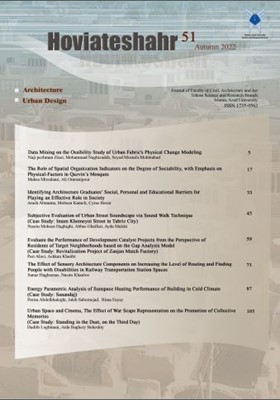بررسی و تحلیل پارامتریک عملکرد گرمایشی گلخانه خورشیدی در اقلیم سرد (نمونه موردی: شهر سنندج)
الموضوعات :پریسا عبدخالقی 1 , ژاله صابرنژاد 2 , ریما فیاض 3
1 - گروه معماری، واحد بین الملل کیش، دانشگاه آزاد اسلامی، جزیره کیش، ایران
2 - دانشکده هنر و معماری، واحد تهران جنوب، دانشگاه آزاد اسلامی ، تهران، ایران.
3 - دانشکده معماری و شهرسازی، دانشگاه هنر، تهران
الکلمات المفتاحية: گلخانه خورشیدی, عملکرد انرژی, اقلیم سرد, شهر سنندج, ساختمان,
ملخص المقالة :
در این مقاله اثرات پارامترهای مختلف گلخانه خورشیدی بر میزان دریافت انرژی و کاهش هدر رفت انرژی ارائه شده است. لذا این دو متغیر وابسته تحت تاثیر پنج متغیر مستقل در 153 حالت مختلف و بهینه ترین حالت با استفاده از الگوریتم ژنتیک در 16758 حالت مختلف مورد بررسی قرار گرفت. انرژی مورد نظر با استفاده از مدلسازی پارامتریک در نرم افزار گرسهاپر، مشاهده مدل سه بعدی در نرم افزار راینو، شبیه سازی انرژی با انرژیپلاس و اعتبارسنجی با نرم افزار دیزاین بیلدر انجام گرفت که نتایج حاصل با نرم افزار دیزاین بیلدر مورد مقایسه قرار گرفت. طبق بررسیها متغیرها در حالتهای زیر بیشترین میزان دریافت انرژی را داشتند: جهت گیری جنوب با20 درجه چرخش به سمت غرب یا شرق، درصد جدار نورگذر به جدار کدر 50%، طول 5متر و عمق مطلوب 1متر. عایق حرارتی از جنس پلی یورتان با ضخامت 10سانتیمتر کمترین کارایی را از لحاظ کاهش اتلاف انرژی در فضای گلخانه داشت.
- ابراهیم پور، عبدالسلام؛ و معرفت، مهدی. (1390). اصلاح روشی جهت تولید داده های اقلیمی TMY برای شهر تهران،مهندسی مکانیک مدرس، ۱۱ (2)، ۷۷-۹۱.
- ابراهیم پور، عبدالسلام؛ و کسمایی، مرتضی. (1392).تهیه فایلهای اقلیمی TMY برای شهرهای مهم ایران، انتشارات مرکز تحقیقات راه، مسکن و شهرسازی.
- احمدی ندوشن، افشین و بهادری نژاد، مهدی، (1385)،کاهش انرژی برودتی و حرارتی مجتمعهای مسکونی با استفاده از بادبزنهای سقفی،چهاردهمین کنفرانس سالانه مهندسی مکانیک،اصفهان.
- رحیمپور، آیدا؛ و رحیمی، مجتبی. (1392). اهمیت و لزوم استفاده از انرژیهای نو در ساختمانهای مسکونی استان کرمان و طراحی. ساختمان سبز،اولین همایش ملی انرژیهای نو و پاک، همدان.
- لکنر. نربرت. (1385).گرمایش، سرمایش، روشنایی رویکردهای طراحی برای معماران، (محمدعلی کینژاد و رحمانآذری، مترجمان)، تبریز: انتشارات دانشگاه هنر اسلامی تبریز. (نشر اثر اصلی:2001)
- مازریا، ادورد. (1385).معماری خورشیدی غیرفعال. (بیژن آقازاده، مترجم). تهران: نشر پیک ادبیات.
- گیلانی، سارا؛ و محمدکاری، بهروز. (1390). بررسی عملکرد گرمایشی گلخانههای خورشیدی در ساختمانهای مسکونی اقلیم سرد نمونه موردی: شهر اردبیل.مهندسی مکانیک مدرس، ۱۱ (۲)، ۱۴۷-۱۵۷.
- Alzoubi, H. H., & Malkawi, A. T. (2015). The optimal utilization of solar energy in residential buildings in light of the Jordanian building regulations. Sustainable Cities and Society, 14, 441-448.https://doi.org/10.1016/j.scs.2014.06.001.
- Attia, S., Hamdy, M., O’Brien, W., & Carlucci, S. (2013). Computational optimisation for zero energy buildings design interviews results with twenty eight international expert. In Proceedings of the 13th Conference of International Building Performance Simulation Association.
- Berardi, U. (2017). A cross-country comparison of the building energy consumptions and their trends. Resources, Conservation and Recycling, 123, 230-241.
- Carlucci, S., Cattarin, G., Causone, F., & Pagliano, L. (2015). Multi-objective optimization of a nearly zero-energy building based on thermal and visual discomfort minimization using a non-dominated sorting genetic algorithm (NSGA-II). Energy and Buildings, 104, 378-394.
- Coakley, D., Raftery, P., & Molloy, P. (2012). Calibration of whole building energy simulation models: detailed case study of a naturally ventilated building using hourly measured data. Building Simulation and Optimization, 57-64.
- Eskin, N., & Türkmen, H. (2008). Analysis of annual heating and cooling energy requirements for office buildings in different climates in Turkey. Energy and buildings, 40(5), 763-773.
- Chiesa, G., Simonetti, M., & Ballada, G. (2017). Potential of attached sunspaces in winter season comparing different technological choices in Central and Southern Europe. Energy and Buildings, 138, 377-395.
- Godoy-Shimizu, D., Steadman, P., Hamilton, I., Donn, M., Evans, S., Moreno, G., & Shayesteh, H. (2018). Energy use and height in office buildings. Building Research & Information, 46(8), 845-863.
- International Energy Agency, Energy Access Outlook 2017, Retrieved October 2016, from
- Jørgensen, O. B., & Hendriksen, O. J. (2000). Glazed balconies and sun spaces–energy savers or energy wasters. In Proceedings of the Third ISES Europe Solar Congress (Eurosun2000), Copenhagen, Denmark, 19-22.
- Moore, F. (1993). Environmental control systems: Heating, cooling, lighting. architecture and urban planninig series. New York: McGraw-Hill.
- Neto, A. H., & Fiorelli, F. A. S. (2008). Comparison between detailed model simulation and artificial neural network for forecasting building energy consumption. Energy and buildings, 40(12), 2169-2176.
- Raji, B., Tenpierik, M. J., & Van den Dobbelsteen, A. (2017). Early-stage design considerations for the energy-efficiency of high-rise office buildings. Sustainability, 9(4), 1-28.
- Taleghani, M., Tenpierik, M. J., & Van den Dobbelsteen, A. A. J. F. (2012). The effect of different transitional spaces on thermal comfort and energy consumption of residential buildings. In 7th Windsor Conference 2012: The changing context of comfort in an unpredictable world, Windsor, UK, 12-15 April 2012.
- Ulpiani, G., Giuliani, D., Romagnoli, A., & di Perna, C. (2017). Experimental monitoring of a sunspace applied to a NZEB mock-up: Assessing and comparing the energy benefits of different configurations. Energy and Buildings, 152, 194-215.
- Yu, J., Yang, C., & Tian, L. (2008). Low-energy envelope design of residential building in hot summer and cold winter zone in China. Energy and Buildings, 40(8), 1536-1546.
- ZEDFactory (2016), Retrieved April 2022


